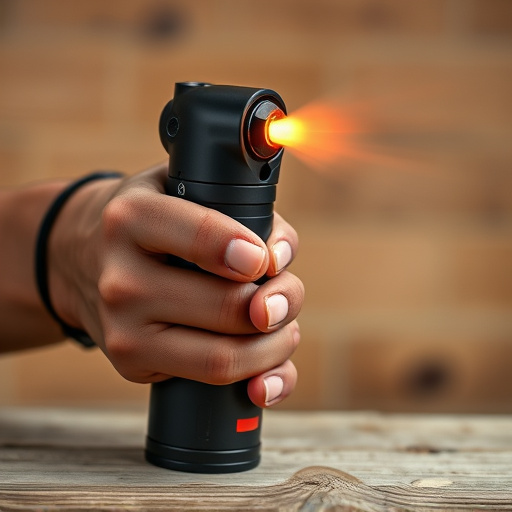In an era of uncertainty, pepper spray has emerged as a vital civilian self-defense tool. The article emphasizes the importance of selecting the best pepper spray delivery methods for maximum effectiveness and minimal user exposure. Common aerosol cans provide broad coverage ideal for crowded spaces, while specialized devices offer precise control for close-quarters encounters. Users should consider factors like range, size, and ease of use when choosing between aerosol sprays, hand-held devices, or clothing-integrated options. Safety measures, including understanding local laws and regular maintenance, are paramount to ensure pepper spray remains a reliable defense mechanism.
In today’s world, civilian protection has become a pressing concern, leading many to explore effective self-defense tools. One such option is inflammatory spray, also known as pepper spray, renowned for its ability to incapacitate attackers temporarily. This article delves into the comprehensive overview of understanding inflammatory spray, focusing on the best pepper spray delivery methods for optimal protection. We’ll explore the role of pepper spray in civilian self-defense and uncover best practices and safety guidelines for its responsible use.
- Understanding Inflammatory Spray: A Comprehensive Overview
- The Role of Pepper Spray in Civilian Self-Defense
- Evaluating Pepper Spray Delivery Methods for Optimal Protection
- Best Practices and Safety Guidelines for Using Inflammatory Sprays
Understanding Inflammatory Spray: A Comprehensive Overview
Inflammatory sprays, commonly known as pepper spray, are non-lethal self-defense tools designed to incapacitate an attacker temporarily. These devices work by delivering a potent irritant called capsaicin into the eyes and respiratory system of the target, causing temporary blindness, coughing, and difficulty breathing. Understanding how these sprays function is crucial when considering their role in civilian protection.
The best pepper spray delivery methods involve direct spraying into the face or eyes at close range. Modern pepper spray devices come in various forms, including handheld canisters, keychains, and even personal defense aerosol systems integrated into clothing or accessories. When choosing a pepper spray for self-defense, it’s essential to look for factors like strength (measured in Scoville Heat Units), range, and the size and convenience of the device. The most effective Pepper Spray Delivery Methods ensure maximum impact while minimizing exposure to the user.
The Role of Pepper Spray in Civilian Self-Defense
Pepper spray, a non-lethal self-defense tool, has become an essential civilian protection measure, especially in today’s uncertain times. It plays a pivotal role in empowering individuals to defend themselves against potential threats and aggressors. The best pepper spray delivery methods are those that ensure rapid and effective deployment, allowing users to maintain their safety and security. Aerosol canisters are the most common form, offering a straightforward approach where a simple trigger pull releases a powerful stream of capsaicin-based agent into the eyes and respiratory system of the attacker, causing temporary blindness, coughing, and difficulty breathing.
This versatile self-defense mechanism is particularly valuable in close-quarters encounters. The portability and discreteness of modern pepper spray devices make them easy to carry, ensuring individuals can respond swiftly when facing danger. Moreover, with various best pepper spray delivery methods available, users have options tailored to different preferences and scenarios, enhancing their ability to protect themselves effectively.
Evaluating Pepper Spray Delivery Methods for Optimal Protection
When considering pepper spray as a civilian protection tool, understanding the best delivery methods is paramount for optimal safety. The effectiveness of pepper spray depends heavily on how it’s deployed, with various factors influencing its impact. For instance, aerosol or canisters are common forms, offering broad area coverage. This method is ideal for creating a barrier against potential threats in crowded spaces or during escape attempts.
However, some delivery systems, like specialized hand-held devices or clothing-integrated sprays, provide more precise control. These allow users to target specific areas, reducing off-target effects and providing better personal protection. Evaluating these methods ensures individuals can make informed decisions based on their needs—whether it’s for self-defense in close quarters or deterring attackers at a distance.
Best Practices and Safety Guidelines for Using Inflammatory Sprays
When considering an inflammatory spray for civilian protection, it’s paramount to understand and adhere to best practices and safety guidelines. For optimal effectiveness, choosing the right pepper spray delivery method is essential. Aerosol or spray-based options are popular due to their ease of use; simply point and spray, ensuring a swift and effective response. However, close-range methods like pepper ball guns or specialized handguns offer more control, ideal for tactical situations where accuracy at close distances is critical.
Safety comes first. Always check local laws regarding the possession and use of inflammatory sprays to ensure compliance. Proper training in pepper spray applications is crucial; it teaches users how to aim accurately, minimize exposure, and handle unexpected reactions. Storing these sprays safely, away from children and unauthorized individuals, is equally important. Regular maintenance, including checking expiration dates and ensuring proper functioning, ensures the spray remains effective when needed most.
Inflammatory sprays, particularly pepper spray, offer civilians an effective self-defense tool against potential threats. By understanding the various delivery methods and adhering to safety guidelines, users can maximize their protection. Evaluating factors like range, intensity, and ease of use ensures individuals can make informed choices when selecting a best pepper spray delivery method tailored to their needs. Remember, proper training and responsible usage are key to ensuring these tools remain effective and safe in the hands of civilians.
